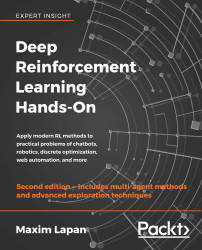OpenAI Gym
After talking so much about the theoretical concepts of reinforcement learning (RL) in Chapter 1, What Is Reinforcement Learning?, let's start doing something practical! In this chapter, you will learn the basics of OpenAI Gym, a library used to provide a uniform API for an RL agent and lots of RL environments. This removes the need to write boilerplate code.
You will also write your first randomly behaving agent and become more familiar with the basic concepts of RL that we have covered so far. By the end of the chapter, you will have an understanding of:
- The high-level requirements that need to be implemented to plug the agent into the RL framework
- A basic, pure-Python implementation of the random RL agent
- OpenAI Gym



